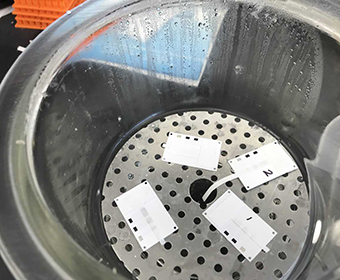
Gorski and McHardy’s strips use electrochemistry to test whether a person has an infection.
(June 11, 2018) -- A new study by Waldemar Gorski, professor and chair of the UTSA Department of Chemistry, and Stanton McHardy, associate professor of research in chemistry and director of the UTSA Center for Innovative Drug Discovery, describes a method that could show quickly and accurately whether a person has been infected with harmful bacteria or other pathogens. Additionally, this new method shows the exact severity of infection in a person.
The most common method of testing for infection in medical facilities is a strip that turns a certain color when infected fluids come into contact with it.
“The problem with this method is that it’s imprecise,” Gorski said. “The human eye is forced to judge the level of infection based on the hue and deepness of a color. It’s difficult to make an accurate call based on that.” Furthermore, roughly a third of samples cannot be tested because the fluids contain blood or are too opaque.
Other methods include microbiology or examining body fluid samples under a microscope and counting white blood cells, also known as leukocytes, which are an indicator of an infection. However, these can be slow processes and require more highly trained personnel.
Gorski, seeing a need for an easier and more rapid method of testing for infection, resolved to test an electrochemical approach, and sought out McHardy, a medicinal chemist. Together, they created molecules that bind to leukocyte enzymes and produce an electrical current to signal the presence of an infection.
Their new molecules are housed on a testing strip. After being contacted with infected bodily fluids, the strip is connected to a computer monitor that displays a clear range of electrochemical responses demonstrating the severity of an infection.
“The signs and symptoms people demonstrate aren’t always reflective of the level of the infection they have,” McHardy said. “This method could very easily show just how serious an infection is and make diagnosis a much quicker process, possibly preventing a more serious illness.”
Gorski believes the method could be especially useful to people who have just undergone surgery, as it could determine definitively whether they have an infection from the procedure before it worsens.
To date, Gorski and McHardy have filed a patent for their invention, published two papers and plan to work with an engineer in the future to streamline its design.
Read Waldemar Gorski and Stanton McHardy’s study, “Synthesis and Characterization of Pyridine Compounds for Amperometric Measurements of Leukocyte Esterase.”
Learn more about the UTSA Department of Chemistry.
Learn more about the UTSA Center for Innovative Drug Discovery.
Connect with UTSA online at Facebook, Twitter, YouTube, Instagram and LinkedIn.
UTSA Today is produced by University Communications and Marketing, the official news source of The University of Texas at San Antonio. Send your feedback to news@utsa.edu. Keep up-to-date on UTSA news by visiting UTSA Today. Connect with UTSA online at Facebook, Twitter, Youtube and Instagram.
Move In To COLFA is strongly recommended for new students in COLFA. It gives you the chance to learn about the Student Success Center, campus resources and meet new friends!
Academic Classroom: Lecture Hall (MH 2.01.10,) McKinney Humanities BldgWe invite you to join us for Birds Up! Downtown, an exciting welcome back event designed to connect students with the different departments at the Downtown Campus. Students will have the opportunity to learn about some of the departments on campus, gain access to different resources, and collect some giveaways!
Bill Miller PlazaCome and celebrate this year's homecoming at the Downtown Campus with food, games, giveaways, music, and more. We look forward to seeing your Roadrunner Spirit!
Bill Miller PlazaThe University of Texas at San Antonio is dedicated to the advancement of knowledge through research and discovery, teaching and learning, community engagement and public service. As an institution of access and excellence, UTSA embraces multicultural traditions and serves as a center for intellectual and creative resources as well as a catalyst for socioeconomic development and the commercialization of intellectual property - for Texas, the nation and the world.
To be a premier public research university, providing access to educational excellence and preparing citizen leaders for the global environment.
We encourage an environment of dialogue and discovery, where integrity, excellence, respect, collaboration and innovation are fostered.